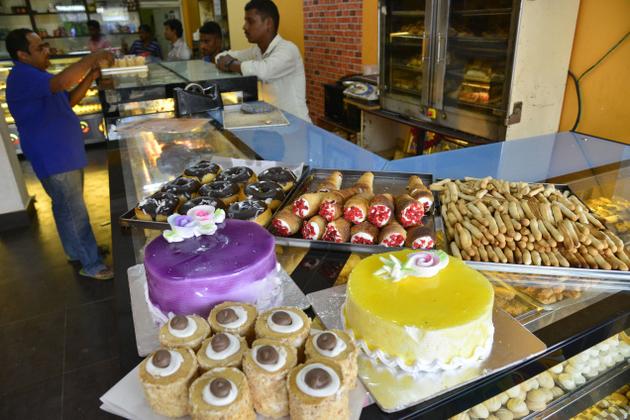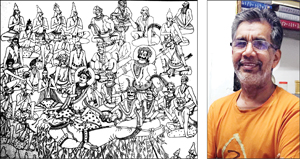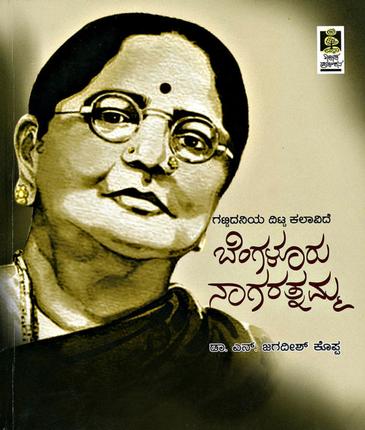Suttur Seer Sri Shivarathri Deshikendra Swamiji, who paid his last respect to Dejagow yesterday, is seen consoling the litterateur’s son Prof. J. Shashidar Prasad (third from right). Writer Bannur K. Raju, Sanskrit University VC Prof. Padma Shekar, writer K. Bhyravamurthy, MLA Vasu, Kannada Activist M.B. Vishwanath and others are seen.

Mysuru :
Noted senior Kannada writer and former Vice-Chancellor of University of Mysore (UoM), Nadoja Prof. D. Javaregowda, popularly known as Dejagow, passed away at a hospital here on Monday. He was 98.
He leaves behind his son J. Shashidhar Prasad, former Vice-Chancellor of UoM and daughter Shashikala, who is settled abroad. His wife Savithramma had predeceased him a few years ago.
Dejagow was admitted to Sri Jayadeva Institute of Cardiovascular Sciences and Research here on Saturday night after he suffered ‘heart failure.’ Though he was in the Intensive Care Unit of the hospital, his condition worsened on Monday and he passed away around 7 pm, according to hospital sources.
Born to Devegowda and Chennamma couple at Chakkere in Channapatna Taluk of Ramanagar District on July 8, 1918, Dejagow, who completed his education at Channapatna and Bengaluru, was later influenced by poet-laureate Kuvempu.
After earning his MA Degree in Kannada, he served the UoM as Professor and has nearly 400 works to his credit, which included Kabbigara Kava, Ramanatha Charite, Leelavathi Prabandham, Hammu Bimmu, Nenapu Kahiyalla and Purathana among others. Dejagow rose to become Vice-Chancellor of the University in 1969 and served till 1975.
In recognition of his contribution to Kannada, the State Government honoured him with ‘Karnataka Ratna’ and ‘Papma’ awards. He was also honoured with ‘Nadoja’ title.
His key contributions included establishing ‘Prasaranga’ — the publication wing of UoM — said to be the first such experiment in South India and giving a fillip to the study of folklore by introducing the subject in both Under-Graduate and Post-Graduate courses, besides setting up a Folklore Museum in the Manasagangotri campus.
The writer revered poet laureate Kuvempu as his guru and followed him.
Dejagow played a big role in pressurising the Union Government to accord the Classical language status to Kannada and in securing Government’s nod to allow candidates to answer KPSC exams in Kannada language.
Dejagow, who played a vital role in getting the Classical language status for Kannada, had sat on a hunger strike for the cause. He had also threatened to return his awards if Kannada failed to get its due.
He was credited with introducing Kannada as a medium of instruction for UG science courses at Yuvaraja’s College, Mysuru.
The writer was awarded ‘Padmashri’ for his contribution to the literary world. Dejagow is considered, perhaps, the only writer in the country to write preface to nearly 10,000 books.
Dejagow was the only Vice-Chancellor who participated in street protests to further the cause of Kannada, while holding office. He had taken part in agitations demanding Karnataka’s fair share in the Cauvery water dispute and seeking safe release of Kannada matinee idol Dr. Rajkumar from forest brigand Veerappa’s clutches in the year 2000.
A votary of Kannada, he was the Chairman of Akhila Braratha Kannada Sahitya Sammelana held at Bengaluru in 1970. He was also a recipient of Gorur award in 2003.
District Minister V. Sreenivasa Prasad, MP Pratap Simha, UoM Vice-Chancellor Prof. K.S. Rangappa, Karntaka Sanskrit University VC Dr. Padma Shekar, writers Prof. K. Bhyravamurthy, C.P. Krishna Kumar and Malali Vasanthkumar, MLA Vasu, Suttur Seer Sri Shivarathri Deshikendra Swamiji were among the dignitaries who visited the writer’s house in Jayalakshmipuram.
Incidentally, Dejagow died on the same date as that of his wife Savithramma, who passed away 10 years ago on May 30, 2006.
Following Savithramma’s death, Dejagow had instituted an award in her name, which was given to women achievers from different fields every year.
An insightful documentary
‘Kannadada Kattalu Dejagow,’ a 30-minute documentary made by award-winning Director Kesari Harvoo for the Information Department, provides an insight into the life, works and contributions of Dejagow to the cause of Kannada. Besides capturing landmark locations in Mysuru where Dejagow severed in his long career as an educationist and writer, Harvoo had also documented the ambience of Chakkere in Channapatna taluk where he was born and brought-up and the Central College in Bengaluru where he studied.
Prominent works of Nadoja
Dejagow’s works include Sahitya Nayasenana Dharmamruta Sangraha, Lakshmishana Jaimini Bharata, Kanakadasara Nalacharitre, Andayyana Kabbigara Kavya, Chikkupadyayana Rukmangada Charitre, Nemichandrana Leelavati Prabhanda, Janapada Adhyayana, Janapada Soundarya, Janapada Vahini, Janapada Geetanjali.
He has translated novels including Jane Austen’s Pride and Prejudice (Hammu Mathu Bimmu), Krishna Hathi Singh’s ‘With No Regrets’ (Nenapu Kahiyalla), Leo Tolstoy’s ‘Anna Karenina’, ‘War and Peace’ (Yudda Mathu Shanti), Resurrection (Punaruthana) and his autobiography ‘Sahithigala Sangadalli Horatada Baduku.’ He also has to his credit many works on Kuvempu’s literature including Sri Ramayana Dharshanam Vachana Chandrike.
Awards and accolades
Prof. Dejagow has to his credits several awards and accolades including Hon. Doctorate from Karnatak University, Hon. Award from Karnataka Sahitya Academy, Rajyotsava Award given by GoK, Senior Fellowship by Dravidian Linguistics Association of Thiruvananthapuram, Pampa Award by GoK, Nadoja award by Kannada University, Nrupatunga award by Kannada Sahitya Parishat, Karnataka Ratna award – 2008, Chidananda Award, Jishampa award, Allama Sri Award and National Basava Award.
Prof. Nadoja, who presided over the 47th Kannada Sahitya Sammelana at Bengaluru in 1970, has been honoured with several felicitation volumes including Antahkarana, Rasashashti, Dejagow-Vyakti mattu Sahitya, Apurva mattu Namma Nadoja, Amrutavarsha and Kayaka Vibhuti.
source: http://www.starofmysore.com / Star of Mysore / Home> General News / May 31st, 2016









